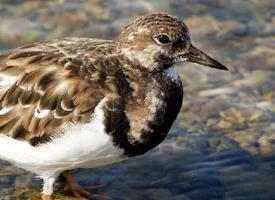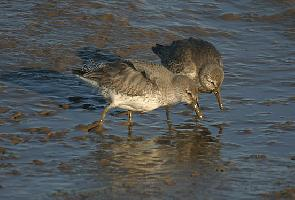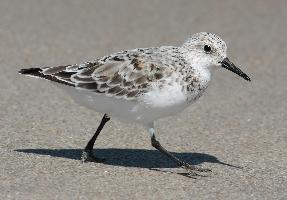
Állatleírás
The Curlew Sandpiper (Calidris ferruginea) is a captivating and slender migratory shorebird, distinguished by its elongated body and gracefully curved bill, reminiscent of the larger curlew, hence its name. This bird is a member of the Scolopacidae family, which includes sandpipers, snipes, and phalaropes. It breeds in the Arctic tundra of Siberia and migrates to coastal wetlands and estuaries across Africa, Europe, South Asia, and Australia for the winter. The Curlew Sandpiper's remarkable journey between its breeding and wintering grounds is a testament to its endurance and navigational skills.Adult Curlew Sandpipers exhibit a striking plumage during the breeding season. Their upper parts are adorned with a rich, rufous color, interspersed with dark feather centers that create a scaled appearance. The breast and underparts are a vibrant chestnut, setting them apart from other waders in their habitat. In contrast, their winter plumage is much subtler, featuring pale grey upper parts and white underparts, with a faint supercilium (eyebrow stripe) visible above the eye. Juveniles resemble adults in winter but have a more pronounced supercilium and a scaly pattern on their backs.
One of the most distinctive features of the Curlew Sandpiper is its bill. The bill is long, slender, and down-curved, perfectly adapted for probing into mud and sand to extract its prey. This adaptation allows it to feed on a variety of invertebrates, including insects, small crustaceans, and mollusks, which it finds in the wetlands and mudflats it frequents during migration and wintering.
Measuring about 18-23 cm in length, with a wingspan of 38-41 cm, the Curlew Sandpiper is a medium-sized wader. It is slightly larger than the closely related Dunlin but smaller and more elegant than the true curlews. Its legs are relatively long and dark, allowing it to wade deeper in search of food, and its flight is swift and direct, with a characteristic flickering wingbeat.
During migration, Curlew Sandpipers often form large flocks, sometimes mixing with other wader species. These congregations can be seen roosting on sandbanks or foraging in the mud, constantly probing and picking at the surface. Their social behavior during these times is a spectacle, as the flocks rise and fall in unison, their bodies glinting in the sunlight.
The Curlew Sandpiper's call is a soft, trilling "chrrr", often heard during flight or when alarmed. During the breeding season, males perform a display flight, ascending high into the air before parachuting down with outstretched wings and tail, all the while emitting a melodious, fluting song designed to attract a mate.
Conservation efforts for the Curlew Sandpiper focus on protecting its breeding and wintering habitats from degradation and loss. As a species that relies on the intertidal zones along major flyways, it is vulnerable to the impacts of climate change, habitat destruction, and pollution. International cooperation is crucial to ensure the survival of this remarkable migratory bird, which continues to inspire and fascinate birdwatchers and conservationists alike.
Hasonló állatok
Új állatfotók
Top 10 állat
- Dolphin gull (Leucophaeus scoresbii)
- Diana monkey (Cercopithecus diana)
- Moustached guenon (Cercopithecus cephus)
- Galápagos tortoise (Geochelone nigra complex)
- Japanese macaque (Macaca fuscata)
- Russian tortoise (Testudo horsfieldii)
- Stone loach (Barbatula barbatula)
- Greek tortoise (Testudo graeca)
- Common flying dragon (Draco volans)
- Vendace (Coregonus albula)


